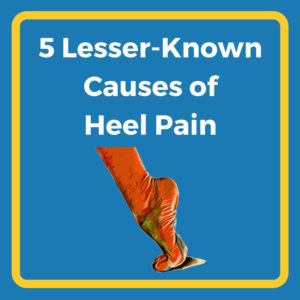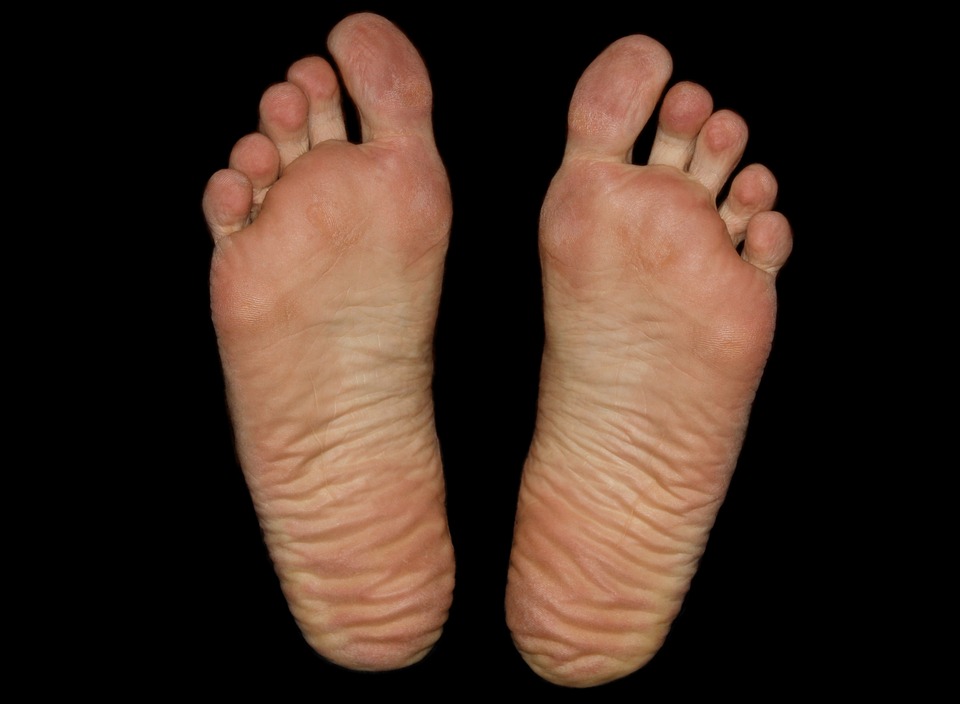 Plantar fasciitis and heel spurs are two of the most common causes of heel pain – but there are other conditions that may cause pain in the heel and arch of the foot.
Plantar fasciitis and heel spurs are two of the most common causes of heel pain – but there are other conditions that may cause pain in the heel and arch of the foot.
If you’ve read the symptoms of plantar fasciitis or tried the common home remedies and it just doesn’t seem to fit, here are five other conditions you may be experiencing.
Click here to learn about our #1 best-selling heel pain treatment.
1. Bursitis of the Heel
Bursitis affects the bursae, which cushion and lubricate major joints of the body. Some people get bursitis of the heel, which occurs when the retrocalcaneal bursa becomes inflamed and irritated.
Unlike plantar fasciitis, pain from bursitis of the heel is usually felt in the back of the heel where it meets the Achilles tendon, not on the bottom of the foot. The skin may also be red, tender, and warm to the touch.
Treatments for Bursitis of the Heel
Treatment for mild bursitis is very similar to that of plantar fasciitis and heel spurs. Rest and ice are the first options to consider when you are experiencing pain. Shoe inserts can also help reduce and prevent pain from bursitis because they cushion the heel and reduce the impact from exercise.

2. Osteomyelitis of the Heel
Osteomyelitis of the heel is a bone infection caused by microorganisms like bacteria and fungi. It is more common in children because of accelerated bone growth, and can also be associated with diabetes.
Osteomyelitis of the heel not only causes localized pain in the joint, but may also have accompanying symptoms of infection like fever and lethargy.
Treatments for Osteomyelitis of the Heel
If you suspect that you may have osteomyelitis, it is important that you visit a physician or podiatrist as soon as possible. Medical treatments include antibiotics and surgery to remove infected tissues.
3. Haglunds Deformity

Haglunds deformity, also known as “pump bump” is the enlargement of the back of the heel bone. It results when the Achilles tendon is caught between the heel bone and the back of the shoe, causing irritation and pain.
Pain from Haglunds deformity can be felt in the back of the heel near the Achilles tendon, and may also involve redness, swelling, and tenderness.
Treatments for Haglunds Deformity
Pain from Haglunds deformity can usually be controlled with anti-inflammatory medications, proper footwear, and icing the area. Orthotics can also help improve positioning of the foot and controlling movement within the shoe, which can also help reduce symptoms.
4. Posterior Tibial Tendonitis
Posterior tibial tendonitis involves the irritation of the posterior tibial tendon. Pain is often experienced with movements involving pushing off from the ground such as walking, running, and jumping.
If you have posterior tibial tendonitis, you may feel pain in the inside of your foot, heel, ankle, and even up a few inches into your shin.
Not sure if you have posterior tibial tendonitis? Try standing on one foot and raising your heel off the floor. If you experience difficulty and pain, you probably have posterior tibial tendonitis.
Treatments for Posterior Tibial Tendonitis
Treatment for posterior tibial tendonitis includes rest, and supportive footwear or shoe inserts to support your arches. Calf and ankle stretches, and strengthening exercises for the posterior tibial tendon can also provide short and long-term relief.
5. Overpronation

Overpronation can cause plantar fasciitis, but it can also cause a variety of other foot, heel, and leg conditions as well. Overpronation is when your foot rolls too far inward, which decreases the foot’s efficiency in absorbing shock and puts excess force on the inner toes.
Pain from overpronation may include heel pain, bunions or pain in the big toe, and tightness in the muscles of the leg. If you suspect you have overpronation, take a look at the tread on your shoes. Most people with overpronation will see unusual wear patterns on the tread, with heavier wear on the inside edge of the sole.
Treatments for Overpronation
Common treatment options for overpronation are orthotic inserts and stretching. Heel and leg pain can often be eased by stretching the foot and calf muscles, and exercising the foot can add stability and prevent future pain.
Having a better idea of what’s really wrong with your heels can help you narrow down a more effective treatment. While plantar fasciitis is the most common heel pain condition, there are many other causes that are lesser-known. When in doubt, talking to your doctor about your heel pain should help you get an accurate diagnosis and treatment plan.




STRETCH, STRETCH, STRETCH and ICE..By doing this I got rid of the PF!!
Thanks for sharing Patricia 🙂 Many people have luck with stretching and icing… and in fact, there’s even research to back it!
Might also add taursal tunnel syndrome. Pain manifests as PF pain; none of the usual PF treatments helped–actually exacerbated the situation. Surgical release resolved the issues–both feet.
What kind of surgery?? I have been diagnosed with both plantar fasciitis and tarsel tunnel syndrome!! I have done everything I have been told to do for both of these diagnoses and still have severe pain!!
Just had the surgrey for tassel tunnel. Best thing I ever did for myself.
Currently getting cortisone shots in my heels for plantar fasciitis, 4
Shots already in both heels 2-3 weeks apart . Anyone get that many shots ? Does
It eventually heal without surgery? I’m on my feet 10+ hours 5 days a week for
Work 🙁
I have dealt with PF since 2006. 2-3 steroid inj. every year. Inj. were no longer giving relief, so I resorted to having PF Sx. Best decision I have made. I no longer think about the pain of walking and have more energy.
What is Pf sx mean? I have pf pain and I would love to know what helped you. Thanks!
As with any medical treatment, sometimes you have to try several different options until you get one that works for you. I have PF in both feet. After months of orthotics, exercises and a cortisone shot in my left foot, all is good. The right foot started being painful and I immediately started exercises and icing along with continued use of orthotics. I had a cortisone shot that kept the pain away for about a week and a half. After an ultrasound, my doctor suggested the Tenex procedure. I am lucky enough to live near the Mayo Clinic in Rochester, MN so I had the procedure done where it was invented. Three months after the surgery I can walk. I can go the whole workday without having to stop and ice my foot. And most importantly, I can get on with my life. Search youtube for the procedure and talk to your doctor about it. Also, I found KURU Shoes. They are simply amazing for support, cushioning, and overall comfort for any foot issue. They are not sold in stores….. check them out online. They are kind of expensive, but well worth it in my book!
Do the kuru shoes fit pretty close to regular show size?
Mine finally did heal, took a long time…over a year. Bought inserts, all brands of shoes, wore me down. Even aggravated the hip and leg…throws your gate off so bad.Foot massages helped and my daughter bought me a Homemedics foot massager..used every day. Really helped more than the shot, shoes or inserts.
My plantar fasciitis actually turned out to be a fractured calcaneus and a torn antsy fascia with scar tissue build up. I suffered for 2 years. Got tired of being told just lose some weight, stretch it, ice it. Finally had surgery
The original gel heel seats from Heel that Pain cured my P.F. Like you, I had the shots on my heel, did everything I could do, but the heel seats are what cured mine!! I have them in all of my close toed shoes now!
I have had really good luck with acupuncture and stretching. Started 3 time a week, now just go in every 3-4 weeks as maintenance. Has done wonders. Inserts from here are also very good.
I have had plantar fasciitis off and on for 2-3 years. (Maybe it is not plantar fasciitis???). I have had PT at three different times for six weeks at a time, have had massage of the foot and calf, have purchased Potalus inner soles for my sneakers and last week, finally visited a foot doctor. She taped my foot and basically told me to just “rest” it and stay off of it as much as I could (even suggested crutches!!!). I see a small improvement, and have to go back to her next week. Very discouraging that this heel and ankle pain keeps returning!
Over supination causes pain and inflamation in the tendon on the outer sole of the foot (from pinky toe to heel). The ortho spotted it right away. I’m still in therapy,and it’s helping some, but not gone yet. Surgery is not an option.
Glad I found this page. My 8 year old son has been coping with heal and arch pain for months. He’s wearing compression socks to bed and I bought better sneakers. Next stop is an appointment wuth his pediatrician on the 19th. Poor guy. 🙁
*with